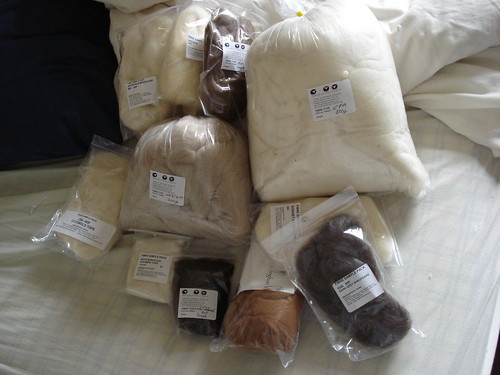The main project I'm spinning for Tour de Fleece consists of fiber samples. I blogged about this briefly before, when I was just starting the project.

The idea is this: To understand the differences between different varieties of fiber, particularly different breeds of sheep, I'm collecting small samples (50g or less) of a wide variety of fibers. Most of them are animal fibers (though I have tried spinning some cotton), and I'm limiting it to natural fibers only - so no acrylic, or nylon, or any of the multitude of flavors of rayon (bamboo, seacell, tencel, milk, corn, et cetera ad nauseum). Other than that, no fiber is too rare or too common - from the ubiquitous merino and BFL, to some tiny precious samples of cashmere and vicuna.
Additionally, the fibers should be in their natural color - or not dyed into rainbow colors, at least. So in the end, I'll have several dozen mini-skeins of all different fibers, in whites, creams, browns, and grays. Going through these fibers I'm really starting to appreciate the wide variety of supposedly 'plain' natural colors. Even a white sheep may not be just white - it could be any range of sparkling snow white, to pale gray, to warm cream.

I'm spinning each fiber on my tiny 6g drop spindle into 2-ply laceweight yarn - either spinning two plies separately, or for small amounts, one ply for an Andean bracelet, then winding into a double-stranded plying ball. If I encounter a fiber that I just can't spin on a suspended spindle, I'll spin it on my tahkli - but I've already spun cotton and camel down with my drop spindle, so I should be able to spin anything.

As far as the nuts and bolts of the spinning go, I can't offer too much technical information - I'm just spinning each fiber 'as it wants to be spun', using my default style of spindle-spinning which is a sort of semi-woolen short draw. For plying, I tend toward the side of overplying rather than underplying. After each yarn is spun & plied, it will be wound into a skein then washed in warm water with Eucalan (unless it's not a hair fiber, like cotton or silk), and then snapped & whacked & allowed to air dry.
Ultimately, I'd like to knit all these fiber samples into a simple shawl, inspired by Shetland hap shawls - something mostly plain, naturally colored, with a simple edging of feather & fan or similar. With upwards of 35 fibers, I should have plenty of yarn to knit the shawl, and I think the subtle stripes of different fibers will add visual (and tactile!) interest.
~Joyuna

 The Grateful Crane Shawl
The Grateful Crane Shawl Elven Slippers
Elven Slippers Russell Square Mitts
Russell Square Mitts Russell Square Tam
Russell Square Tam iTouch Jumper
iTouch Jumper Twisty Wristband
Twisty Wristband Mawata Pulsewarmers
Mawata Pulsewarmers
It should be fascinating to have a "library" of different fibers to get to know them, what a great idea!
ReplyDelete